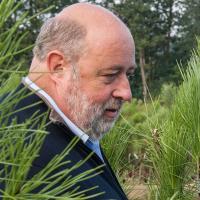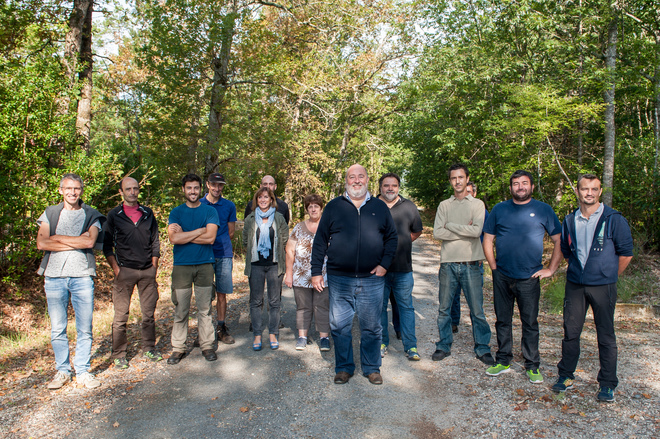
Biodiversity Reading time 7 min
Patrick Pastuszka, reeling in Innovation
Published on 13 December 2016
At the Pierroton Forestry Experimental Unit, Patrick Pastuszka cuts a fine figure both for his impressive stature and for kindhearted nature. “I’m always enthusiastic about leading projects and working towards collective goals,” says Pastuszka with his trademark sincere smile. This keen fisherman hooked an idea that led to his greatest successes: “bridging the gap between researchers and industry professionals.”
Spirit of the Landes Forest
Disseminating research results among professionals
After 10 years as an engineer at the Conifer Improvement Laboratory, Patrick Pastuszka became head of the Forestry Experimental Unit in 1994. “The Landes Forest is the basis for the region’s economy. Maritime pine is a remarkable endemic species with a tremendous output, despite the difficult conditions it grows in,” says Pastuszka. Pastuszka came up with the concept of a seed orchard in his nursery. “We use the term ‘VF’ for each generation of tree. ‘V’ for vigour and ‘F’ for form, which are the main criteria for assessing the speed and quality of growth,” he says. “The seeds we collect provide industry professionals with improved stock to plant.” While innovations happen over a long term, the current generation is used in more than 95% of maritime pine reforestation in Aquitaine at present. “VF3, in production since 2011, will meet the needs of the next 15 years. But, we are already testing out new things for VF4,” he says.
Building dialogue with industry stakeholders has always been important for Pastuszka. Twenty years ago, he set up the Maritime Pine of the Future scientific interest group (GPMF), which he still leads. The group originally focused solely on genetics, but now brings together the range of public and private forestry research and development stakeholders. “We also collaborate extensively with researchers, Annie Raffin and Céline Méredieu (1) in particular.” The programme is highly regarded and is a source of pride for Pastuszka. “It is a wonderful tool for making research more accessible to industry users.”
To stay among the top research and dissemination programmes, Pastuszka is very much aware that equipment must be kept up to date. He has brought his long-term strategic vision to INRA’s National Commission for Experimental Units (CNUE), which he has led since 2007. Over the years, his innovative systems and tools have been recognised as an Equipment of Excellence (EquipEx).
Team trainer
A hotbed of ideas!
“A wonderful technological success. We have been able to keep apace with change through the contracts and projects we have been involved with.” With Xylosylve, one of six technical facilities in the Xyloforest EquipEx, Pastuszka is aiming big. It is a €1.8 million project over a 40 hectare site whose aim is to develop the forestry systems of tomorrow. “It was a part of the first round of the Investments for the Future Programme. We were lucky that we did not have to build everything from scratch; the groundwork and partnerships were already in place.”
To deepen his ties with research, Pastuszka draws on his boundless energy and a secret weapon. “I have my own mug stashed away in various coffee corners,” he jokes — the ideal site for discussions that can lead to major projects. As research director Laurent Augusto (2) explains, “Patrick drove the creation of the facility, which is also a part of the ICOS programme (3).” Xylosylve is an in situ facility for measuring and monitoring soil biochemistry and biogeochemistry. “He is wonderfully personable and highly skilled, and always attentive to his team’s work environment,” says Augusto.
In 2011, Pastuszka landed the EU REINFFORCE project, a network of arboreta stretching from Portugal to Scotland designed to monitor the health and growth of tree species on the European Atlantic seaboard in the light of climate change. “The EU made significant contributions in terms of methodology. Our site brings together 35 deciduous and coniferous species with 150 different provenances and is wholly managed by one of our technicians,” says Pastuszka. The Unit brings together 20 staff members working in a flat organisational structure. Each person is responsible for technical systems or experimental networks. “It’s such a pleasure for me to lead a young, motivated team that’s making an important contribution to the EU’s work.”
In keeping with the collaborative nature of his career successes, for Pastuszka the Award is really meaningful only if it is shared. “What I’m happiest about is that this Award recognises all the team’s work,” ha says. A true reward for this extraordinary leader whose strong team spirit is matched only by his drive to push the frontiers of his field of expertise.
What's next?
“INRA is a wonderful workplace that has given me the chance to explore many roles and to collaborate with terrific people,” Pastuszka says of his distinguished career, which is a source of pride and satisfaction. “I was trusted to work in positions of responsibility and was given the resources I needed to work.” Of paramount importance for him now is passing on to his successors the tools and infrastructure needed to continue contributing to INRA’s growth. “The gains we have made must be sustained. And the EU must foster missions that support INRA’s development.” With Pastuszka set to hand over the reins in a few short years, his next mission as a new retiree will be to “take it easy”.
(1) Joint Research Unit for Biodiversity, Genes and Communities (BIGECO), INRA Bordeaux-Aquitaine, Pierroton site
(2) Joint Research Unit for Soil–Plant–Atmosphere Interaction (ISPA), INRA Bordeaux-Aquitaine, Pierroton site
(3) Established in 2008, Integrated Carbon Observation System (ICOS) is an EU infrastructure project for long-term monitoring of greenhouse gases developed by CEA, INRA, and CNRS-INSU. The project is lead by France and is incorporated into 35 very-large-scale research instruments (TGIR).

© INRAE, B. Nicolas
- 57 years old, married, two children
- 1981: Engineering degree in forestry from the French National School of Water and Forestry Engineers
- 1984: Joins INRA as a research engineer at the Conifer Improvement Laboratory in the Forestry Research Division, INRA Bordeaux
- 1993: Research engineer at the Forest Wood Cluster – Aquitaine, INRA Bordeaux-Aquitaine
- since 1994: Director of the Pierroton Forestry Experimental Unit, INRA Bordeaux-Aquitaine
- since 1996: President of the Maritime Pine of the Future scientific interest group (GPMF)
- since 2007: Coordinator of the National Commission for Experimental Units (CNUE)
- Interests: Actively involved in volunteering: secretary of a traditional fishing association, vice president of a football club, volunteer in a pétanque club
Prizes and awards
- 2008: Knight of the Agricultural Order of Merit
- 2015: Officer of the Agricultural Order of Merit
- 2016: INRA Award for Technological Innovation
